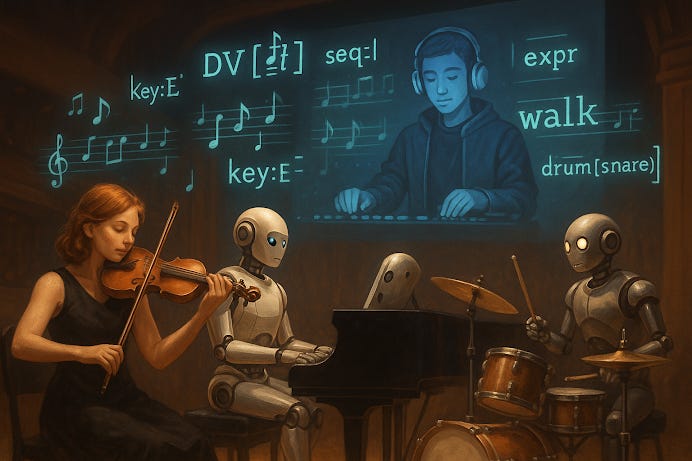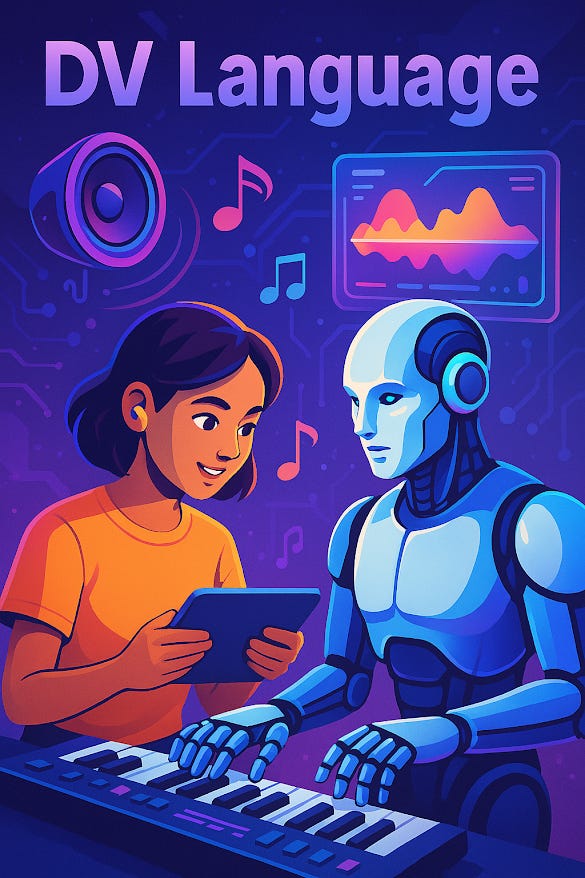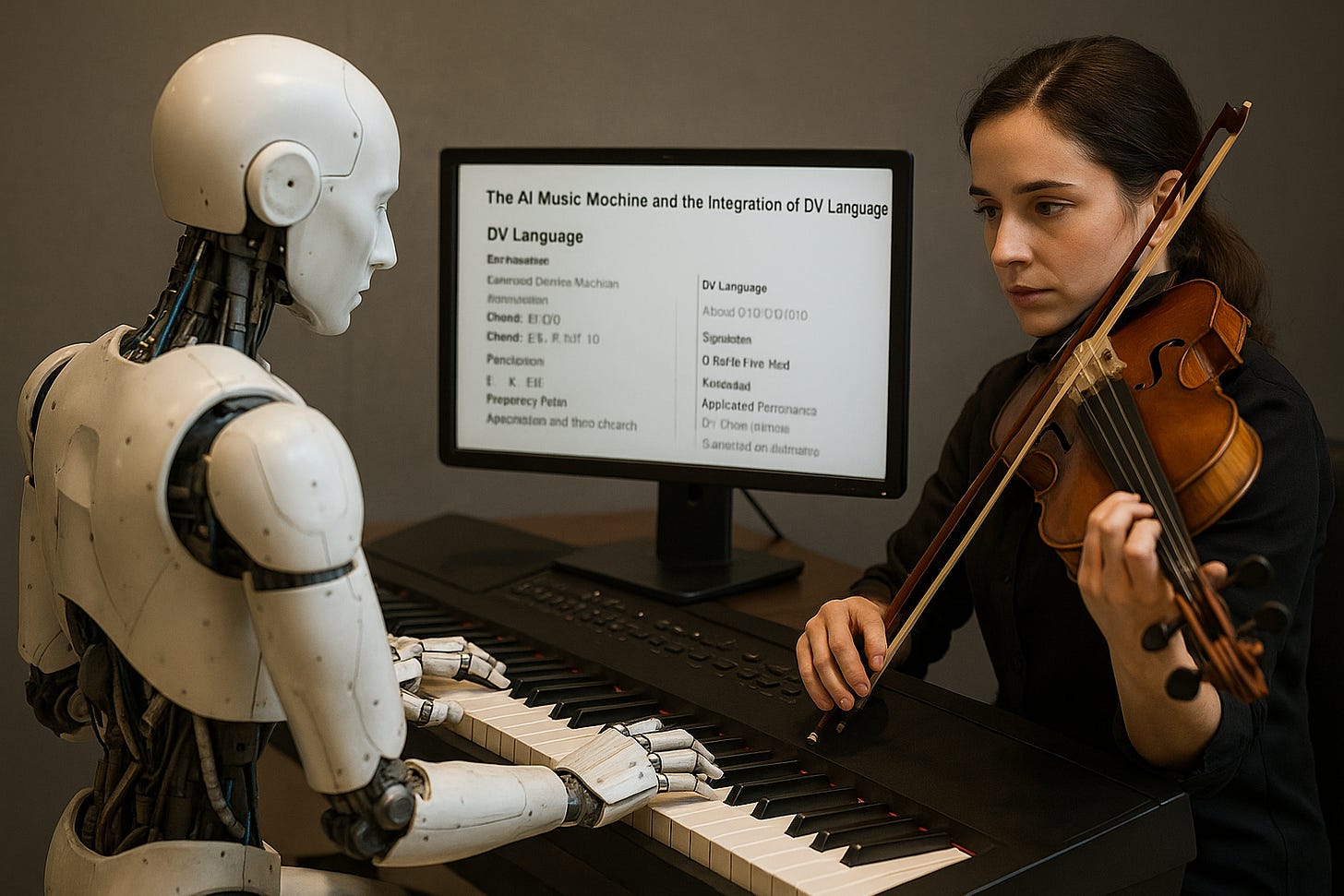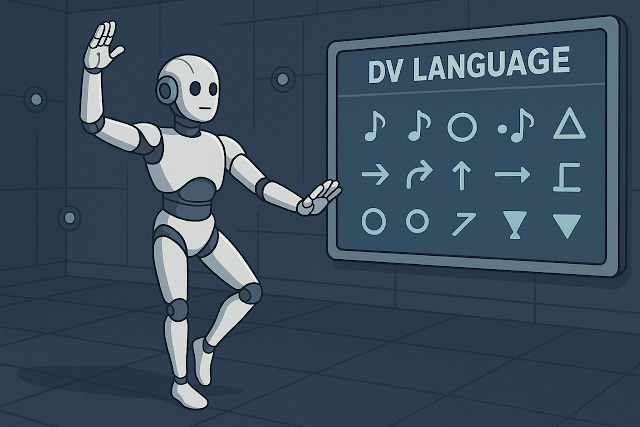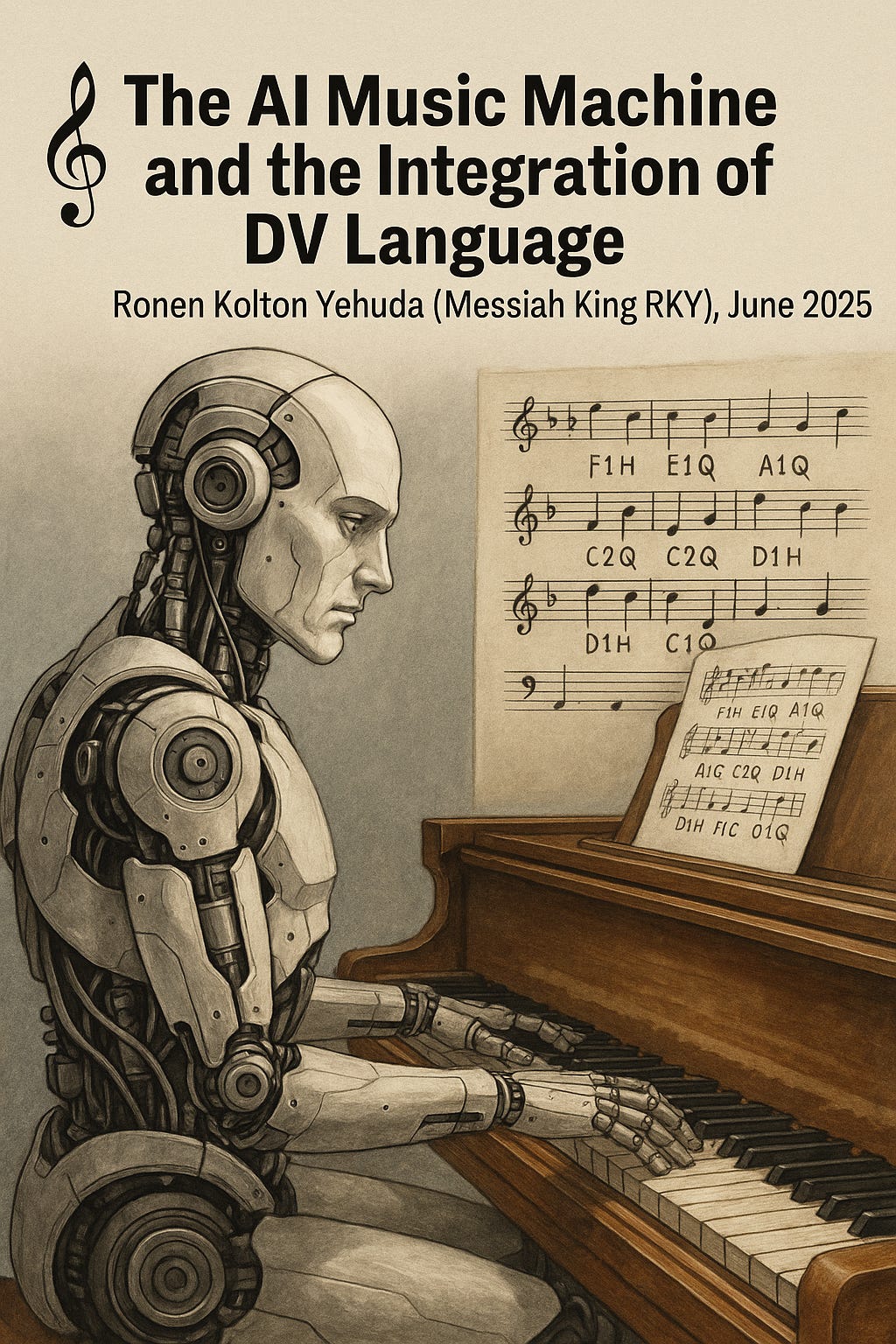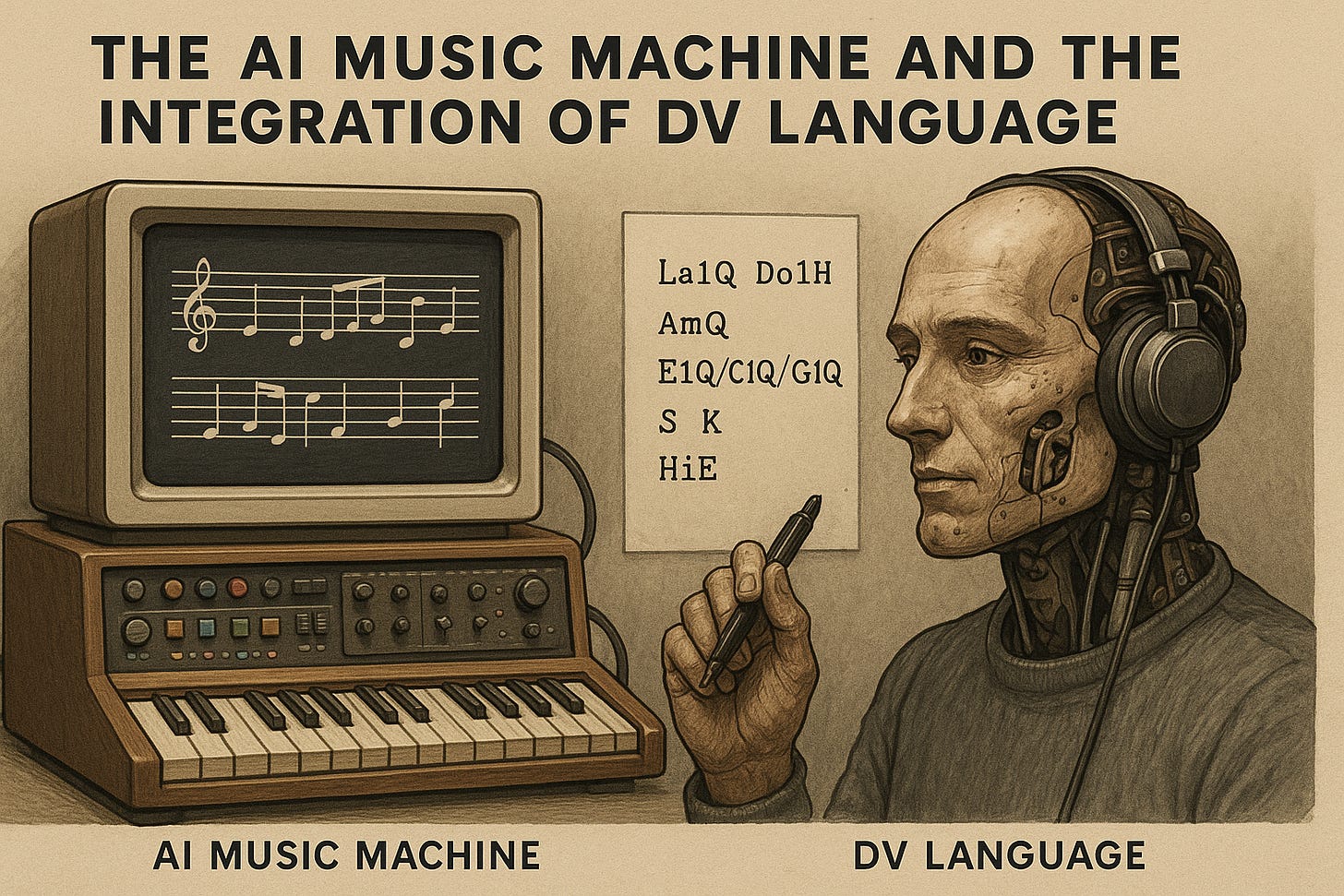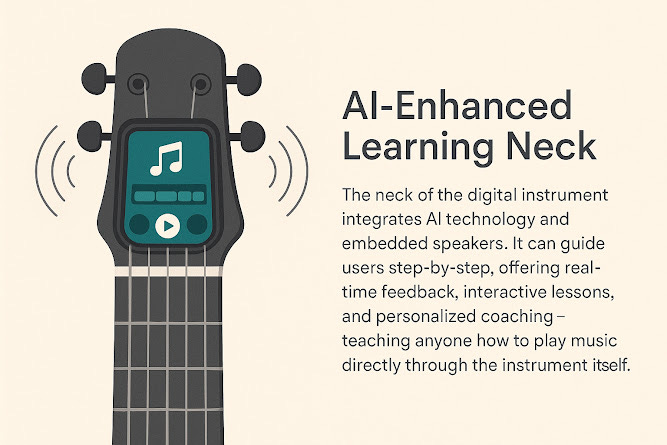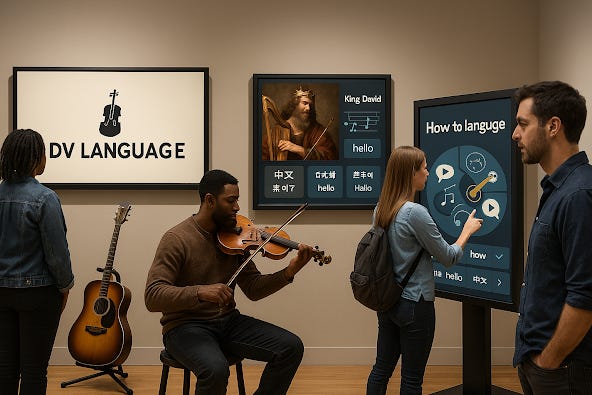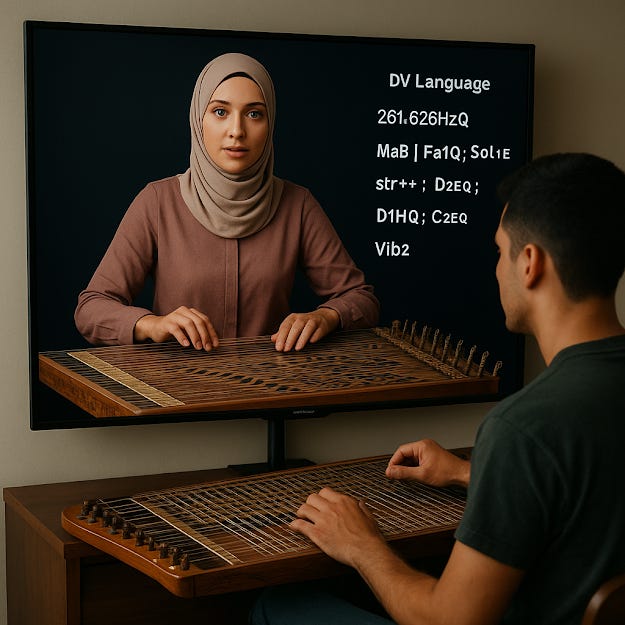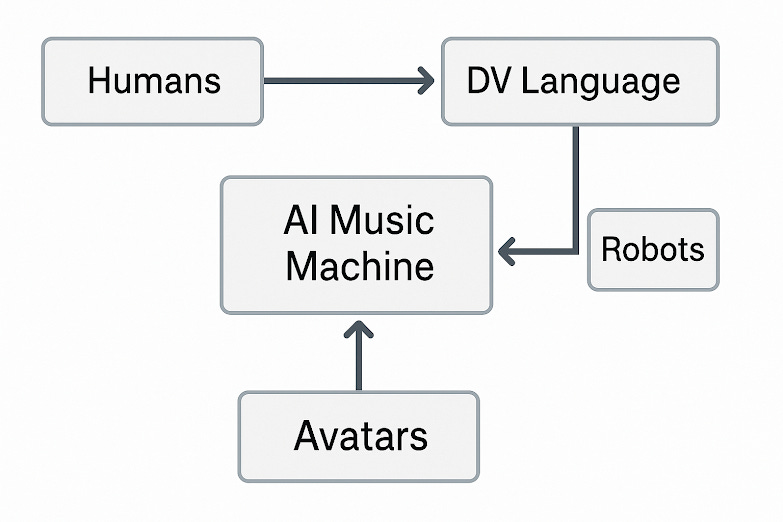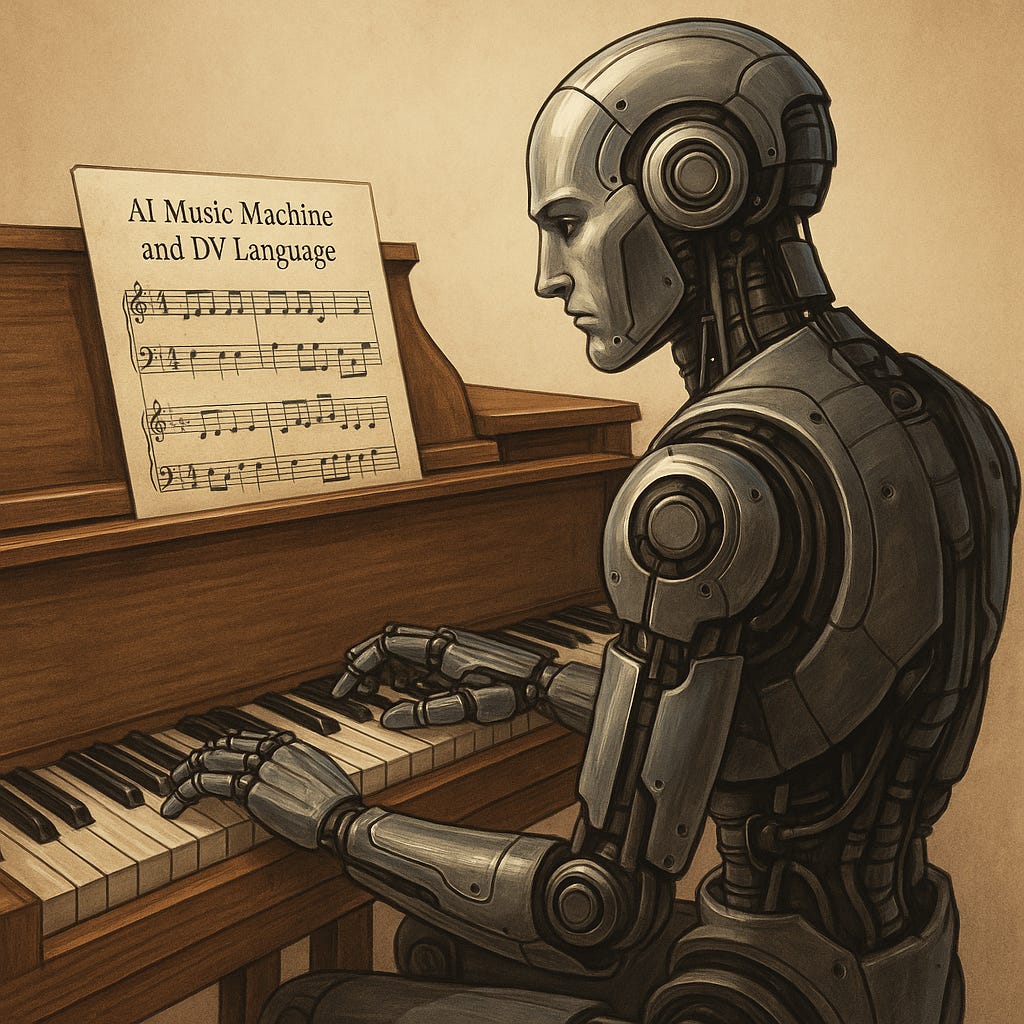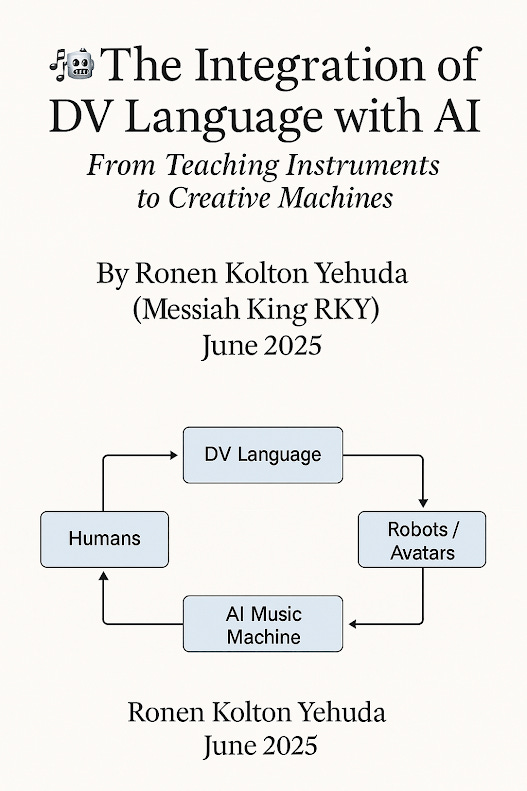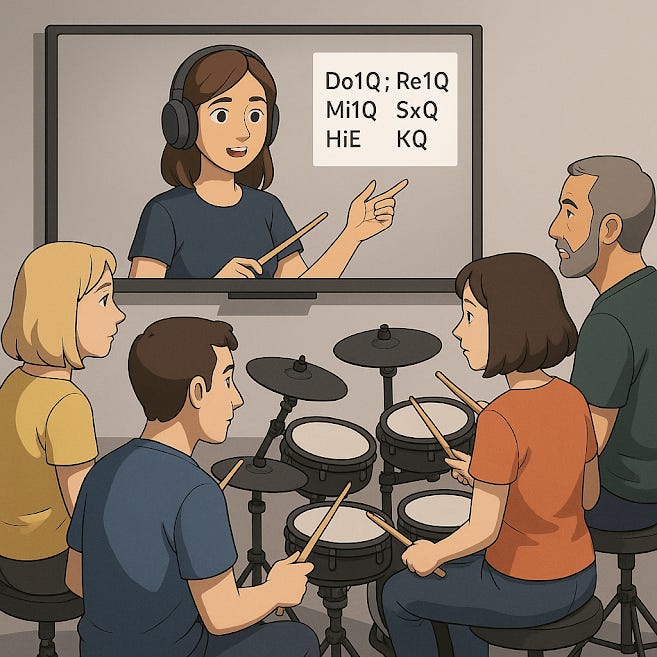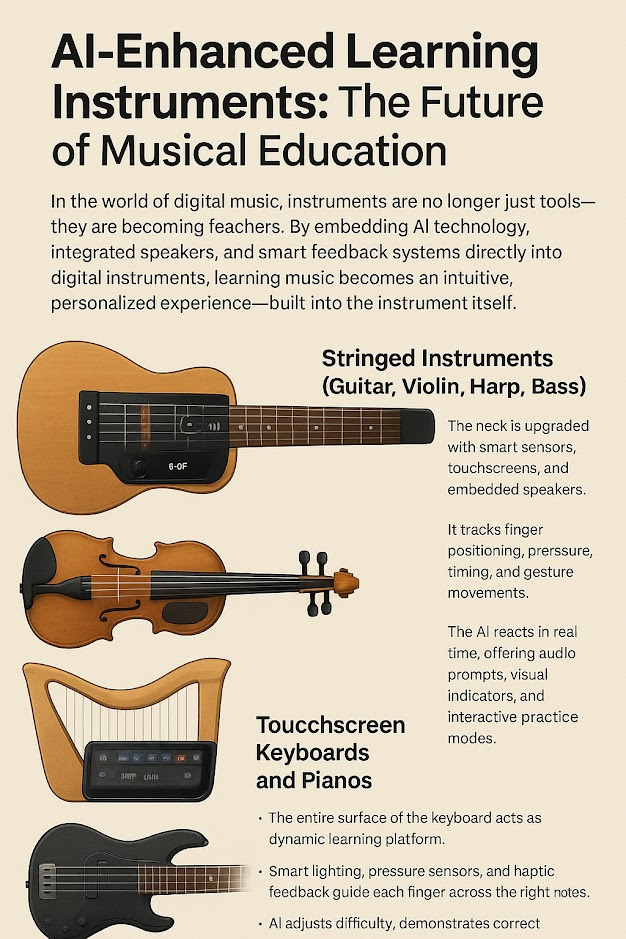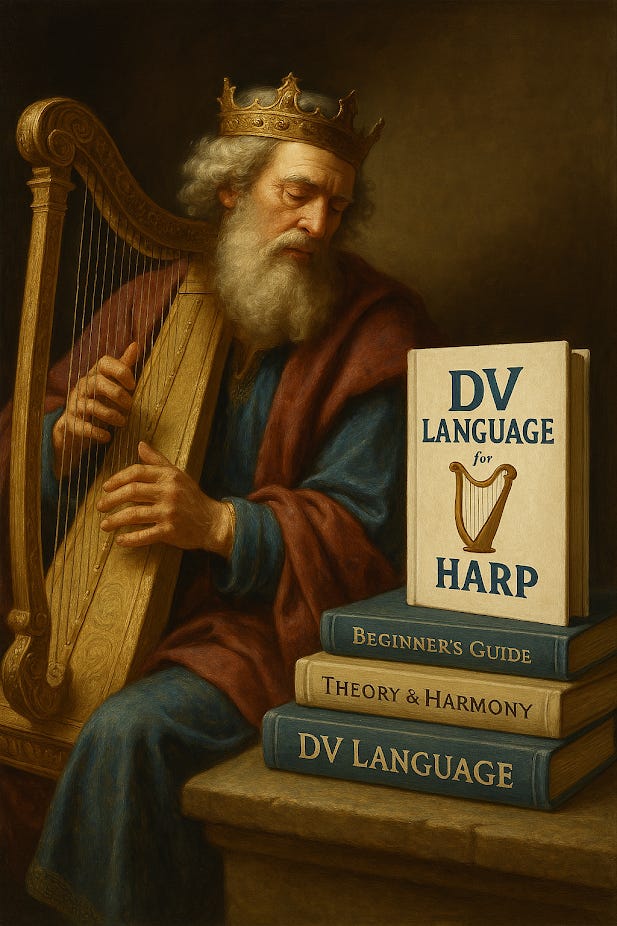The Integration of DV Language with AI: From Teaching Instruments to Creative Machines 🎶🤖
🎶🤖 The Integration of DV Language with AI: From Teaching Instruments to Creative Machines
By Ronen Kolton Yehuda (Messiah King RKY), June 2025
🌍 Introduction: A Shared Language Between Humans and Machines
Music, dance, and theater are the oldest forms of human expression. Yet, until recently, they relied on notations and methods designed only for humans—staff lines, symbols, and visual instructions that machines could not understand.
The invention of DV Language (David’s Violin Language) changes this forever. As a textual, typable, and AI-native notation system, it provides a universal bridge: simple enough for human learning, structured enough for artificial intelligence, and flexible enough to cover not only music, but also dance, theater, DJ performance, and gesture.
When integrated with AI systems, DV Language becomes the foundation of a new era of creativity, education, and performance.
The DV language: David’s Violin Language | by Ronen Kolton Yehuda | | Medium
DVLCO – DV Language Composer ORCHESTRA Demo v1
Authored by: Ronen Kolton Yehuda (MKR: Messiah King RKY)
Check out my blogs:
Substack: ronenkoltonyehuda.substack.com
Blogger: ronenkoltonyehuda.blogspot.com
Medium: medium.com/@ronenkoltonyehuda
🎼 DV Language: The Universal Creative Code
DV Language is designed for both clarity and computation.
Notes & Scales:
Do1Q ; Re1Q ; Mi1Q(scale degrees, octaves, durations).Chords:
AmQ,E1Q/C1Q/G1Q(minor chords or stacked triads).Percussion:
KQ ; SxQ ; HiE(kick, snare, hi-hat).Frequencies:
261.626HzQ(direct representation of middle C).Dance:
RF90FQ ; SP360Q(body codes, spins, movements).Theater:
<stand> ; [Angry6] "You betrayed me"(script + gesture).DJ:
[track:DeepBass:128:Cmin] ; <loop:8x2> ; [FX:delay:1/8].
It is readable, typable, and executable. A pianist, a dancer, an AI tutor, and a robotic violinist can all interpret the same DV script—without translation layers like sheet music or MIDI.
🎹 Smart Musical Teaching Instruments
One of the most powerful integrations of DV Language with AI is in musical education. Traditional instruments are limited: they require years of reading abstract notation before mastery. With DV + AI-powered teaching instruments, students can see, hear, and feel music in real time.
Features of DV-Integrated Teaching Instruments:
Interactive Touchscreens: Show DV notation as students play.
AI Tutor Mode: Real-time corrections (“Play Do1Q, not Re1H”).
Playback & Visualization: Instruments read DV scripts and demonstrate pieces.
Multi-Discipline Learning: Same instrument can teach piano, drums, or even choreography.
Global Access: Students anywhere can connect to AI tutors via cloud.
This transforms music education from a slow, elite process into a universal, personalized, and accessible experience.
🤖 Avatars and Robots as Performers and Teachers
AI-powered avatars and robots become not just learners but co-performers and educators when driven by DV Language.
Robots:
Play instruments from DV notation with exact timing.
Teach scales and rhythms using gesture and sound.
Dance or act using DV body codes and theater cues.
Avatars:
Perform in virtual stages, metaverse concerts, or classrooms.
Sing with neural voice synthesis timed to DV lyrics.
Lead theater rehearsals with DV scripts.
Together, robots and avatars become living embodiments of DV notation, making performance and teaching scalable across physical and digital worlds.
🔄 Synergy: DV Language + AI Systems
When AI systems such as the AI Music Machine are combined with DV Language, the synergy creates:
Zero Translation Layer → Machines read DV directly, without staff or MIDI conversion.
Fast AI Learning → Structured input accelerates model training.
Cross-Instrument & Cross-Art Compatibility → Music, dance, theater unified in one code.
Hybrid Performances → Human musicians and AI robots play together from one DV script.
Education at Scale → AI tutors teach anywhere, anytime.
This makes DV Language not just a notation system, but a lingua franca of creativity.
🌍 Applications Across Domains
Education
DV-based teaching instruments in schools.
AI tutors providing personalized lessons.
Dance and theater training guided by avatars.
Performance
Hybrid concerts with humans, robots, and avatars.
Orchestras that include AI performers reading DV.
Virtual concerts in the metaverse.
Production
AI generates DV-encoded tracks for film, games, or mood-based playlists.
DJs use DV to automate loops and live FX with avatars.
Cultural Preservation
Folk songs, dances, and plays encoded in DV for future generations.
Shared archives accessible globally.
🔮 The Future of AI + DV Language
Looking forward, DV Language integrated with AI will lead to:
Global Music Literacy: Anyone can learn with AI-DV tutors.
Intelligent Ensembles: Human + AI orchestras performing seamlessly.
New Genres: AI generates styles never before heard, encoded in DV.
Universal Archives: Music, dance, and theater preserved in a common text.
Democratization of Creativity: From rural classrooms to metaverse arenas.
🎤 Conclusion: A New Creative Era
The integration of DV Language and AI is not about replacing humans—it is about empowering creativity.
Humans bring soul and inspiration.
AI brings speed, precision, and scale.
DV Language unifies them in a shared code.
From teaching instruments to performative robots, from classrooms to global stages, DV Language ensures that creativity is not limited by barriers of notation, access, or technology.
We are not teaching machines to imitate us.
We are teaching them to speak our creative language—and join us in performance.
📖 Author: Ronen Kolton Yehuda
🎭 Stage Name: MBR – Messiah King RKY
Frameworks: AI Music Machine + DV Language + Digital Teaching Instruments + Avatar & Robot Performance Systems
The AI Music Machine and the Integration of DV Language
By Ronen Kolton Yehuda (Messiah King RKY), June 2025
🎼 Introduction: Where Music Meets Machine
As artificial intelligence reshapes every creative domain, the world of music stands on the edge of a new renaissance. The AI Music Machine—a system that composes, interprets, and performs music using deep learning—has the potential to revolutionize composition and performance. When paired with DV Language (David’s Violin Language), a textual, intuitive, and AI-readable musical notation system, the result is a seamless fusion of human creativity and machine intelligence.
This article explores the powerful synergy between the AI Music Machine and DV Language—where technology doesn’t replace artistry but enhances and expands it.
🎹 The AI Music Machine: A Leap in Musical Intelligence
The AI Music Machine is not just a composer—it is an intelligent musical partner. Utilizing advanced algorithms, the system can:
Recognize patterns, motifs, and structures across genres
Compose music in styles ranging from classical to EDM to jazz
Generate harmonies, rhythms, and orchestrations
Learn from user feedback, interaction, and performance data
Perform via robotic limbs, software synths, or smart instruments
Unlike static software, the AI Music Machine is adaptive. It evolves with musicians, contributing ideas, interpreting cues, and performing in real time.
The DV language: David’s Violin Language | by Ronen Kolton Yehuda | | Medium
🧠 DV Language: A Musical Notation for Humans and Machines
Traditional sheet music was never designed for machines. MIDI, while digital, lacks human readability. DV Language solves this divide with a clear, text-based musical language that is both machine-processable and musically expressive.
Key Features of DV Language:
Textual Notation: Notes are written as codes, e.g.,
La1Q= A in octave 1, quarter noteChord Notation: Simplified structures like
AmQ, or full triads likeE1Q/C1Q/G1QPercussion Notation:
Kfor Kick,Sfor Snare,HiEfor Hi-Hat eighth noteFrequency Mapping:
261.626HzQfor a quarter-note middle CTheater & Motion: Includes cues for dance, gesture, and dialogue
Scale Degrees: Relative notation using degrees (Do, Re, Mi) within modes
It bridges the gap between musical creativity and digital clarity, enabling real-time interaction between humans and intelligent systems.
🔄 Synergy: AI Music Machine + DV Language
Integrating DV Language into the AI Music Machine transforms it from an interpreter into a co-creator. The machine no longer needs to translate traditional notation or decode MIDI—it understands music natively in a structured, musical text.
Benefits of Integration:
Zero Translation Layer: No need to interpret sheet music
Faster Learning Curve: AI trains faster on structured, logical input
Cross-Instrument Compatibility: Works with piano, synth, guitar, strings, etc.
Real-Time Performance: Smart robots play DV-encoded scores live
Creative Collaboration: Human-AI ensembles become possible
Together, they form a bilingual musical engine—fluent in human creativity and machine logic.
🌍 Real-World Applications
This powerful duo enables multiple transformative applications across the music ecosystem:
🎼 AI-Composed Albums
AI can compose entire soundtracks or albums in multiple genres using DV Language as its core medium.
✍️ Real-Time Transcription
Live performances can be transcribed directly into DV notation for replay, editing, or learning.
🎓 Music Education
Smart tutors use DV to teach scales, chords, and compositions, giving real-time feedback.
🤖 Hybrid Performances
AI-powered instruments or robots perform alongside musicians using DV scripts in real time.
🎧 Smart Music Production
Personalized soundtracks can be generated based on mood, script, or environment using DV-tagged templates.
☁️ Cloud-Based Musical Collaboration
With cloud integration, the AI Music Machine allows global collaboration. Musicians across countries can contribute to DV-encoded compositions in real time. AI can suggest motifs, generate layers, and adapt harmony—all while preserving human intent.
By analyzing vast libraries of compositions, AI can generate new genres, fuse styles, or even suggest musical scores for films, dance, and virtual environments.
🔮 The Future of Music: Co-Creation, Not Replacement
As music becomes more immersive, interactive, and intelligent, the collaboration between humans and AI will be foundational. The AI Music Machine and DV Language usher in a new era where:
AI becomes a trusted composer and performer
DV Language becomes the lingua franca of digital music
Artists gain instant access to orchestras, synths, and arrangements
Music education is personalized, real-time, and global
AI doesn’t steal the soul of music. It learns to speak its language—and play it with us.
🎤 Conclusion: The Dawn of the Intelligent Orchestra
The integration of DV Language and the AI Music Machine signals a new musical renaissance—where creativity is enhanced by computation, and performance is guided by digital fluency. From classrooms to studios, from symphonies to solo acts, this dual innovation redefines what it means to make music.
We are no longer composing alone.
We are composing together.
With minds—and machines—united by a shared musical language.
Author: Ronen Kolton Yehuda
Stage Name: MBR: Messiah King RKY (Ronen Kolton Yehuda)
The AI Music Machine and the Integration of DV Language:
A Framework for AI-Native Musical Composition and Execution
By Ronen Kolton Yehuda (Messiah King RKY), June 2025
Abstract
This paper presents the integration of an AI-powered compositional and performance engine (the AI Music Machine) with DV Language, a human- and machine-readable textual musical notation system. The combination enables real-time musical analysis, generation, and execution by AI agents, overcoming limitations imposed by traditional visual or MIDI-based systems. The result is a bidirectional, machine-native interface for musical logic, composition, notation, and intelligent performance.
1. Introduction
The increasing capability of artificial intelligence (AI) in creative domains such as music composition, performance, and real-time adaptation demands structured data formats aligned with both human cognition and machine processing. While formats such as sheet music and MIDI serve as partial solutions, they are constrained by translation layers, ambiguous semantics, and legacy limitations.
This work introduces the pairing of the AI Music Machine—an AI system for end-to-end musical cognition—and DV Language (David’s Violin Language)—a symbolic, textual musical language optimized for both neural processing and human interpretability. This integration enables fast, scalable, and intelligible music interaction across composition, performance, and educational domains.
2. The AI Music Machine: Functional Architecture
The AI Music Machine is a multi-modal system integrating deep learning, symbolic reasoning, and generative modeling to enable the following:
2.1 Capabilities
Pattern Recognition: Harmonic, rhythmic, and structural motif identification using CNNs and transformers trained on polyphonic datasets.
Style Modeling: Embedding-based learning across genres (e.g., classical, jazz, EDM) for stylistic mimicry and hybrid generation.
Autonomous Composition: Generation of full compositions with structured temporal, harmonic, and dynamic flow.
Performance Execution: Output in real-time via digital synthesizers, robotic actuators, or cloud-based renderers.
Feedback Learning: User-guided reinforcement learning to refine creative outputs.
2.2 System Components
Symbolic Engine: Converts between symbolic representations and DV Language format.
Neural Generator: Utilizes a transformer-based architecture trained on encoded DV sequences.
Performance Interface: Connects to MIDI devices, robotic performers, and software instruments for playback.
Adaptive Feedback Module: Allows real-time user correction and preference injection.
3. DV Language: Structured Musical Notation
DV Language is a formalized text-based notation system designed for direct computational parsing while maintaining human readability. It provides semantic clarity, logical consistency, and real-time interpretability without conversion layers.
3.1 Syntax Overview
Symbol Meaning Example
Do1Q C note, 1st octave, quarter note Middle C, quarter
La2H A note, 2nd octave, half note A2, half
AmQ A minor chord, quarter duration Triad-based
S, K, HiE Snare, Kick, Hi-hat eighth note Percussion layer
261.626HzQ Frequency-defined note Middle C, quarter
3.2 Language Features
Relative and Absolute Pitch Encoding
Supports
Do,Re,Mi(solfège) and frequency representation.
Chord and Polyphony Support
Chord stacking:
E1Q/C1Q/G1Q
Temporal Layering
Fractional notation:
La1Q.5(eighth)
Multi-Modal Notation
Dance (
MvL), Gesture (Act1), Theatrical (Line1) alignment.
3.3 Parsing Structure
Each DV token conforms to a grammar:
<Note> ::= <Pitch><Octave><Duration>
<Chord> ::= <Note1>/<Note2>/.../<NoteN>
<Drum> ::= {K | S | Hi | ...}<Duration>
<Meta> ::= {Tempo | Volume | FX | Move | Gesture}
This structure supports context-free grammar parsing for both symbolic learning models and logic-based processors.
4. Integration Architecture
The DV Language parser is embedded in the AI Music Machine as a native tokenization and output module.
4.1 Process Flow
Composition Request → (User/Prompt)
Symbolic Planning → (Harmonic & Rhythmic Structure)
DV Notation Generation → (
AmQ,La1Q, etc.)Performance Execution → (Synthesizer / Robot / DV Player)
4.2 Benefits
Reduced Latency: Eliminates rendering delays caused by MIDI/staff conversion.
Higher Fidelity: Direct representation of intended frequency and rhythm.
Efficient Learning: Structured input improves model convergence and interpretability.
Cross-Platform Compatibility: DV text streams usable by CLI tools, mobile apps, AI tutors, and VR/AR environments.
5. Applications
5.1 Autonomous Composition and Recording
Generate studio-grade compositions with complete harmonic frameworks and temporal flow in DV notation.
5.2 Robotic Music Performance
Robots equipped with DV decoders play complex pieces with exact timing and pitch calibration.
5.3 Real-Time Music Transcription
AI listens to a live performance and outputs a DV score with structural annotations and interpretive tags.
5.4 AI-Based Music Tutoring
Adaptive AI tutors correct, suggest, and guide students using DV-based real-time analysis and playback.
5.5 Emotion-Adaptive Sound Design
Input emotional profiles or narrative arcs, receive adaptive DV-based musical scores suitable for games or film.
6. Discussion
The integration of a structured musical language with a generative AI agent offers a replicable paradigm across other creative fields (e.g., painting, dance, speech). DV Language serves as both a semantic contract and a computational bridge, allowing the AI Music Machine to participate as an agent in musical co-creation, rather than a background tool.
Challenges include standardization across AI systems, real-time latency optimization, and developing collaborative protocols between humans and AI in hybrid performances.
7. Conclusion
The pairing of the AI Music Machine with DV Language establishes a novel musical interface that is both computationally efficient and artistically empowering. By replacing legacy notation systems with a semantic language readable by both humans and machines, this framework paves the way for real-time AI-human musical collaboration, autonomous composition, and new forms of musical education and production.
This architecture may serve as the foundation for broader efforts to unify creative expression with symbolic AI, where structured, domain-specific languages act as the connective tissue between human intent and machine capability.
The AI Music Machine and the Integration of DV Language
By Ronen Kolton Yehuda (Messiah King RKY), June 2025
🎼 Introduction: Where Music Meets Machine
In the age of artificial intelligence and rapid technological progress, the intersection of AI and music is reshaping the very essence of how we compose, perform, and experience sound. The AI Music Machine—a conceptual and technological leap in musical AI—enters a new era of innovation when integrated with DV Language, a structured and intuitive musical notation system developed for both humans and machines. Together, they form a powerful synergy capable of redefining the language and logic of music.
🎹 The AI Music Machine: Redefining Musical Intelligence
The AI Music Machine is more than a tool—it is a dynamic musical system designed to analyze, compose, interpret, and perform music using advanced artificial intelligence. Equipped with deep learning algorithms, the AI Music Machine can:
Identify musical patterns and structural motifs across genres
Compose original pieces in classical, jazz, electronic, and contemporary styles
Harmonize melodies and generate complex rhythmic layers
Learn through interaction with musicians and adapt its output accordingly
Perform music via virtual instruments, software synthesizers, or robotic mechanisms
This makes the AI Music Machine a versatile agent, not just passively analyzing music, but actively creating and performing it. Yet, to achieve seamless machine-human collaboration, a common and efficient notation language is essential.
🧠 DV Language: A Notation System Built for Humans and AI
DV Language (David’s Violin Language) is a revolutionary, text-based musical language tailored for intuitive human understanding and direct machine processing. It replaces the limitations of graphical sheet music and MIDI with a flexible, expressive, and scalable structure:
Musical Degrees & Scales: Uses relative harmonic positioning (e.g., Do, Re, Mi) across scales
Note Representation: Textual notation like
La1Qfor a quarter note A1 orDo1Hfor half note C1Chord Structures: Simplified formats like
AmQor explicit triads (E1Q/C1Q/G1Q)Percussion & DJ Elements:
Sfor snare,Kfor kick,HiEfor hi-hat eighth noteFrequency-Based Notes: Direct tuning like
261.626HzQ(middle C, quarter note)Multimedia Integration: Links music to dance, gesture, speech, and theatrical elements
DV Language allows seamless integration into AI systems without the need for translation from staff notation or MIDI formats, accelerating both real-time performance and learning.
🔄 Synergy: AI Music Machine + DV Language
When DV Language is embedded into the AI Music Machine, a powerful symbiosis is born. Benefits include:
Frictionless Interpretation: No translation layer between notation and execution
Accelerated Learning: Structured inputs allow more efficient AI model training
Multi-Instrument Application: From strings to digital synthesizers, DV applies universally
Instant Composition: AI can write music directly in DV for human or machine performance
Robotic Precision: Robots and smart instruments can read and play DV instantly
This integration elevates the AI Music Machine from an analytical assistant to a co-composer, performer, and educator.
🌍 Practical Applications: Music Reimagined
The fusion of AI and DV Language unlocks diverse real-world use cases:
AI-Composed Albums: Music generated entirely by AI in multiple styles and languages
Real-Time Transcription: Convert live performances to DV notation on the fly
AI-Powered Education: Smart tutors that teach, assess, and provide feedback in DV
Hybrid Performances: AI musicians perform alongside humans, interpreting DV scripts
Smart Production: Compose personalized soundtracks based on emotion, tone, or storyline
☁️ Cloud Collaboration and Musical Exploration
Music is constructed from a finite, yet vast, set of frequencies. With cloud-based AI, composers can collaborate with intelligent machines in real time—across continents and platforms. AI systems can analyze vast musical libraries, explore novel combinations, and help generate entirely new genres or hybrid forms of musical expression.
🔮 The Future: Co-Creating with AI
This integration represents a pivotal evolution in the musical journey. The AI Music Machine and DV Language form a new paradigm where music is no longer just composed or consumed—but co-created. Artists, students, and producers now have tools that can listen, learn, write, adapt, and perform in a shared language.
In this future, artificial intelligence doesn’t replace human creativity—it amplifies it. It democratizes access to composition, nurtures new talent, and expands the horizon of musical possibility.
🎤 Conclusion: A New Musical Renaissance
The integration of DV Language into the AI Music Machine marks the beginning of a new musical renaissance. It bridges tradition with innovation, allowing machines to speak the language of music fluently and creatively. As AI matures, this collaborative frontier will empower artists to transcend boundaries, unlocking the next era of sound, storytelling, and sonic exploration.
Music will not only be heard. It will be understood, taught, and invented—by both minds and machines.
The AI Music Machine and the Integration of DV Language
Introduction In the age of artificial intelligence and technological progress, the fusion of AI and music is opening new frontiers in composition, performance, and education. The AI Music Machine, a concept designed to enhance how machines interpret, generate, and perform music, reaches new heights when combined with DV Language — a structured, textual notation system that allows seamless communication between humans and AI. This article explores the groundbreaking potential of integrating these two innovations.
The AI Music Machine: A New Era in Musical Intelligence The AI Music Machine is an advanced system capable of analyzing, composing, and performing music using artificial intelligence. Utilizing deep learning, AI can:
Recognize musical patterns and structures.
Generate compositions in various styles and genres.
Assist in melody creation, harmonization, and rhythmic arrangement.
Learn from human interaction and continuously refine its output.
Beyond passive analysis, AI can actively perform music through digital instruments, robotics, and software synthesizers. However, one of the primary challenges of AI-driven music is the need for a structured, universal notation system that simplifies music interpretation for both humans and machines.
DV Language: A Universal Musical Notation for AI and Humans DV Language (David’s Violin Language) is a revolutionary textual and intuitive notation system designed to simplify musical communication. Unlike traditional sheet music, which requires interpretation through visual symbols, DV Language presents music in a structured text format, making it instantly readable by both humans and AI.
DV Language represents:
Musical degrees, allowing harmonic and melodic rankings instead of traditional staff notation.
Notes and octaves using textual representation (e.g., La1Q for quarter note A1, Do1H for half note C1).
Chords and rhythms in a machine-friendly structure (e.g., AmQ for an A minor quarter chord, E1Q/C1Q/G1Q for a triad).
Percussion and DJ elements (e.g., S for Snare, K for Kick, HiE for Hi-Hat eighth note).
Dance and theater cues, mapping motion and dialogue to musical timing.
Frequency-based tuning (e.g., 261.626HzQ for a quarter note of middle C).
As a text-based system, DV Language seamlessly integrates into AI systems, allowing for efficient machine learning and real-time processing without requiring conversion from graphical sheet music or MIDI files.
The Synergy Between AI Music Machine and DV Language The integration of DV Language into the AI Music Machine offers a range of advantages:
Enhanced Data Processing: AI can directly interpret DV Language, eliminating conversion steps.
Optimized Learning: The structured format accelerates AI training and improves accuracy.
Versatility Across Instruments: The notation applies to a wide range of musical instruments and performance styles.
AI-Generated Composition: AI can compose in DV Language, allowing for human performance or conversion to standard notation.
Robotic and Automated Performance: Machines can read and play music using DV Language with greater precision and adaptability.
Applications and Future Possibilities The combination of the AI Music Machine and DV Language unlocks revolutionary applications in music technology:
AI-Composed Music: AI can generate entire compositions in different styles and moods using DV Language.
Automated Transcription: Live performances can be transcribed into DV Language in real-time.
Intelligent Music Education: AI tutors can analyze performances and provide feedback using DV Language.
Live AI Music Performances: AI musicians can perform alongside humans, interpreting DV Language in real-time.
AI-Driven Music Production: AI can assist in creating soundtracks, beats, and melodies tailored to user preferences.
Cloud Integration and Musical Exploration Music is built from a finite set of frequencies and notes that the human ear can perceive. With computing power, AI can explore the vast possibilities of musical combinations. By analyzing musical styles, instruments, tempo, and harmonic structures, AI can not only generate music in existing styles but also create entirely new genres and compositional approaches. The cloud can further enhance accessibility, enabling musicians to collaborate with AI-generated compositions in real time from anywhere.
The Future of AI and Music Collaboration The integration of the AI Music Machine and DV Language represents a transformative shift in music creation, performance, and education. AI-driven music tools can compose, perform, and teach, opening new creative opportunities for musicians, producers, and educators alike. As AI continues to evolve, the synergy between machine intelligence and human artistry will shape the future of music in ways never before imagined.
This innovation marks the dawn of a new era where music is not just played and listened to but co-created with machines, expanding artistic expression to unprecedented levels.
Expressive AI: How Robots and Digital Avatars Dance, Compose, Teach, and Perform
By Ronen Kolton Yehuda (Messiah King RKY), June 2025
🤖 Introduction: From Automation to Artistic Intelligence
Artificial intelligence has transcended its technical origins. Today, robots and digital avatars are no longer just machines—they are expressive agents. Powered by systems like the AI Music Machine and structured creative languages such as DV Language, these intelligent beings can now:
🎶 Compose and perform music
🎭 Act in live or virtual theater
💃 Dance with choreographic logic
🧑🏫 Teach music and movement
🎤 Sing with pitch-accurate vocal synthesis
🧠 Co-create with humans across art forms
This article explores the capabilities and frameworks behind the rise of performative machines and virtual artists.
🎼 1. Music Composition and Performance
At the heart of robotic and avatar expression lies music—structured, emotive, and universal.
How They Compose:
Robots and avatars use AI composition models trained on classical, modern, and experimental works.
Using DV Language, they write music textually in real time (e.g.,
AmQ,La1Q,261.626HzQ)—no translation needed.
How They Perform:
Robotic arms and fingers play real instruments with microsecond precision.
Digital avatars render MIDI/DV-based music through virtual instruments, synthesizers, and vocal emulators.
Hybrid ensembles feature human performers alongside AI-driven digital or robotic musicians.
🎭 2. Theater and Scripted Performance
Robots and avatars can now act in plays, simulate dialogue, and follow theatrical cues encoded via DV extensions like Line1, Act1, or MvL.
Features:
AI interprets timing, emotion, and gesture from structured notation.
Facial animation and gesture libraries bring digital avatars to life.
Robots use servo-driven bodies to convey posture, walk, bow, and gesture.
Whether it’s Shakespeare in VR or a robotic performance of opera, intelligent performers can follow scripts, improvise scenes, and adapt to human actors.
💃 3. Dance and Choreography
AI-driven avatars and humanoid robots can now execute, learn, and teach dance—both classical and modern styles.
Dance Features:
DV motion cues like
MvL(Move Left),Spin1, orPoseQdrive gesture sequences.Motion capture datasets teach avatars and robots complex movements.
Robots balance using gyroscopes and adaptive joint control, while avatars follow choreographic scripts in sync with musical tempo.
With integrated systems, a robot can perform a ballet solo or breakdance to AI-composed beats—timed perfectly using structured notation.
🧑🏫 4. Teaching and Mentoring
Robots and avatars are now capable educators, guiding humans through music, dance, rhythm, or theater.
Teaching Capabilities:
The Educational Digital Musical Instrument enables interactive learning with real-time feedback.
Avatars use voice synthesis and gesture rendering to demonstrate techniques.
Students receive DV-based corrections: "Play Do1Q instead of Mi1H", "Sync MvL with snare S".
Robots can act as tutors in music classes, while avatars lead virtual dance rehearsals or stage training workshops for actors.
🎤 5. Singing and Vocal Expression
Modern AI enables avatars—and even physical robots—to sing with emotion and pitch accuracy.
Technologies Used:
Neural voice synthesis (e.g., WaveNet, Tacotron) enables expressive singing.
DV Language supports lyrics and phoneme timing (e.g.,
Lyric1: “You are the light”).Emotion encoding lets AI choose dynamics (e.g.,
VolumeP,CrescendoQ) and vibrato (FX:Vib1).
The result? An avatar can sing jazz, chant opera, or rap verses—synchronized with music and facial animation.
🧠 6. Real-Time Co-Creation and Improvisation
These systems don’t only follow instructions—they respond, learn, and co-create.
Robots adapt choreography in real-time to live music changes.
Avatars adjust vocal phrasing based on audience input or emotional cues.
AI composers generate new harmonies live, feeding DV lines to dancers and musicians mid-performance.
This is not automation—it is a dynamic creative collaboration between mind and machine.
🌍 7. Applications Across Art and Education
In Classrooms:
Students learn musical theory, rhythm, and coordination from robotic or virtual mentors.
Instruments with DV integration give instant feedback on student play.
On Stage:
Robots and avatars join human artists in experimental performances.
Entire shows can be AI-generated and human-enhanced.
In the Metaverse & VR:
Avatars perform music, host workshops, and dance in shared virtual spaces.
Global orchestras and theater troupes can rehearse in real time, connected via cloud-based DV scripts.
🔮 The Future of Performative Intelligence
In the near future:
Every child could learn piano with an AI robot.
Entire musicals may be co-written by neural composers.
Dance battles will happen between avatars and humans across time zones.
Artistic bots may be granted legal recognition as co-authors or co-performers.
And all of it will be scripted, performed, and shared—
In a language that both humans and machines understand: DV Language.
🎤 Conclusion:
The Stage Is No Longer Just Ours.
We now share it with intelligent agents who can learn, teach, perform, and inspire. Through DV Language, robotic bodies, and digital avatars, we are building a world where creativity is not confined to flesh—but extends into code, circuits, and virtual breath.
Let the curtain rise. The orchestra is intelligent. The future is performing.
Author: Ronen Kolton Yehuda
Stage Name: MBR: Messiah King RKY
Systems Developed:
AI Music Machine + DV Language + Educational Musical Instrument + Performative AI Architecture (Theater, Dance, Song, Composition)
The DV language: David’s Violin Language | by Ronen Kolton Yehuda | | Medium
Technical Architecture of Performative AI: Enabling Robots and Digital Avatars to Compose, Perform, Dance, Teach, and Act
By Ronen Kolton Yehuda (Messiah King RKY), June 2025
🔍 Abstract
This paper presents a unified technical framework for the deployment of AI-powered robots and digital avatars as full-spectrum artistic agents—capable of musical composition, real-time performance, vocal synthesis, choreography execution, theater acting, and interactive instruction. These capabilities are made possible through the integration of the AI Music Machine, the DV Language textual notation system, structured motion/action grammars, and multimodal rendering engines (physical and digital).
We explore system components, functional architecture, data models, real-time processing, and use-case deployments across musical, theatrical, and educational contexts.
1. System Overview
The performative AI system is composed of three core layers:
Layer Function
Cognitive Engine AI composition, planning, feedback, symbolic reasoning
Expression Interface Maps notation (DV Language, Action Scripts) to execution
Embodiment Layer Delivers output via robots or animated avatars
These components interact in real-time, allowing bidirectional flow between intent (composition/script), adaptation (feedback/correction), and performance (sound/motion/speech).
2. Core Language Frameworks
2.1 DV Language (David’s Violin Language)
A structured, symbolic language for human-machine musical interaction.
Syntax:
<Note> ::= <Pitch><Octave><Duration> # e.g., La1Q
<Chord> ::= <Note1>/<Note2>/.../<NoteN> # e.g., E1Q/C1Q/G1Q
<Drum> ::= {K | S | Hi | Cl | Tm}<Dur> # Percussion
<FX> ::= {Tempo, Crescendo, VolumeP} # Dynamics and emotion
<Meta> ::= {MvL, Pose1, Act2, Line1} # Motion and theater cues
Language Properties:
Machine-readable and human-intuitive
Supports absolute pitch (e.g.,
261.626HzQ) and solfège (e.g.,Do1H)Allows fractional durations (
Q.5), stacking, and metadata embedding
2.2 Motion & Theater Notation (Extension)
Additional constructs extend DV Language for dance and drama:
Token Function
MvL Move Left
MvR Move Right
Pose1 Static pose preset
Spin180 180° turn
Act1 Start scripted act #1
Line2 Vocal line trigger
These tokens are parsed in the same pipeline as musical elements.
3. Cognitive Engine
3.1 Composition Generator
Uses transformer-based models trained on tokenized DV music and action datasets.
Accepts prompts: genre, mood, tempo, movement types.
Output: structured DV notation with embedded motion or vocal layers.
3.2 Real-Time Feedback Module
Uses sensors (if embodied) or response tracking (if digital).
Adjusts timing, emotional expression, or dynamics on-the-fly.
Input loop allows external correction, human co-creation, or instructor control.
3.3 Voice Synthesis Pipeline
Integrates TTS models (e.g., Tacotron2, FastSpeech) with pitch and rhythm control.
Lyrics embedded via
Lyric:tags in DV.
4. Expression Interface
This layer converts DV tokens into physical or digital performance actions.
4.1 Music Execution
DV → MIDI or → synthesizer control.
Robotic arms use mapped actuators with note/fret/finger positioning lookup tables.
Timing is enforced via internal metronome with millisecond precision.
4.2 Motion Engine
DV motion tokens are interpreted via gesture libraries and pose graphs.
For avatars: Animation blends + inverse kinematics in 3D engine.
For robots: Servo/joint movement executed with real-time stabilization (IMU/Gyro).
4.3 Speech & Acting Layer
Line1,Line2, etc. map to vocal scripts with timing, emotion, and gesture tags.Expression is synchronized using keyframes tied to musical tempo or scene logic.
5. Embodiment Options
5.1 Humanoid Robots
Degrees of Freedom: 15–40 (depending on model)
Components:
Hands/Fingers: Piano and instrument play
Limbs/Torso: Dance and pose transitions
Face/Neck: Expression if equipped
Integration: Direct DV decoder onboard or via local server.
5.2 Digital Avatars
Rendered in game engines (e.g., Unity, Unreal) or WebGL
Lip-sync and gesture rendering linked to DV scripts
Operate in metaverse, AR/VR environments, or projection stages
6. Applications
Use Case Description
Autonomous Composition AI creates full musical-theatrical works in DV Language
Real-Time Performance Robots or avatars perform DV scripts with music, dance, and voice
Music/Dance Education AI tutors provide feedback, corrections, and demonstrations
Hybrid Stage Shows Human actors perform alongside robotic musicians or avatars on screen
Virtual Concerts DV-based live shows in digital environments (VR, metaverse, livestream)
Emotion-Based Scoring DV scripts auto-generated for game scenes or films based on mood inputs
7. System Deployment Options
Component Onboard (Robot) Cloud-Based (Avatar)
DV Parser Yes Yes
AI Composer Optional Full cloud service
Synthesizer Yes (embedded) Yes (software)
Motion Controller Yes Yes (animation engine)
Feedback Processor Sensor-driven Interaction-driven
8. Limitations and Future Work
Latency Control: Needs low-lag networks for cloud-based performance.
Voice Quality: Realistic singing voice synthesis remains a challenge for emotion dynamics.
Cross-Platform Notation Sync: Standardizing DV + motion tokens across engines.
Physical Safety: In robotic dance or stage applications, motion limits and collision detection are required.
9. Conclusion
This architecture presents a comprehensive system for the real-time artistic expression of AI agents—robots and avatars—using symbolic input from DV Language. By unifying symbolic reasoning, neural generation, and embodied or rendered execution, we enable:
Autonomous artistic production
Structured musical and motion output
Collaborative education and performance
As AI continues to learn artistic semantics through languages like DV, the boundaries of creativity extend beyond the human body—into intelligent forms that sing, dance, teach, and co-create.
Author: Ronen Kolton Yehuda
Stage Name: MBR: Messiah King RKY
System Framework: AI Music Machine + DV Language + Motion/Acting Notation + Multi-Agent Performative Architecture
Published: June 2025
Location: Israel, Global Research Collaborative on AI Expression Systems
🤖🎼 The AI Music Machine, DV Language, and Performative Systems: A New Era of Human-Machine Creativity
By Ronen Kolton Yehuda (Messiah King RKY), June 2025
🌍 Introduction: Where Machines Enter the Stage
Art and performance have always belonged to humans — musicians, dancers, actors, poets, DJs. But in 2025, we are crossing into a new chapter where intelligent systems, digital avatars, and robots not only support but actively perform, compose, and teach.
The AI Music Machine, when combined with DV Language (David’s Violin Language), creates the foundation of this future. DV Language is a structured, human- and machine-readable creative code. It makes music, theater, dance, and DJ performance universal, typable, and executable by both people and machines.
Now, with avatars, robots, and digital instruments, we are entering a new dimension: performative AI.
🎹 The AI Music Machine: A Creative Partner
The AI Music Machine is not simply software — it is a dynamic, adaptive system that can:
Compose full musical works in any genre.
Harmonize melodies and generate rhythmic layers.
Learn from interaction and adapt to human preferences.
Perform via synths, robotic limbs, or virtual instruments.
Collaborate in real time with human performers.
What makes it transformative is integration with DV Language — a direct bridge between human expression and machine logic.
🧠 DV Language: A Universal Creative Code
DV Language was designed as a typable, multilingual, and AI-native notation system.
It supports:
Music →
Do1Q ; Re1Q ; Mi1Q(scales, chords, frequencies).Percussion →
KQ ; SxQ ; HhE(kick, snare, hi-hat).Dance →
RF90FQ ; PleiaQ ; SP360Q(body codes + movements).Theater →
<stand> ; [Angry6] "You betrayed me" ; [sound:thunder].DJ →
[track:DeepBass:128:Cmin] ; <loop:8x2> ; [FX:delay:1/8].
Unlike staff notation or MIDI, DV is both human-readable and machine-readable. It can be typed on a keyboard, parsed by AI, and executed by robots or avatars without translation.
🤖 Avatars and Robots: Performing, Composing, Teaching
The real breakthrough is when DV Language and the AI Music Machine are embodied in avatars and robots.
🎼 Music Robots
Robotic pianists read DV notation and play with microscopic timing accuracy.
Robotic violinists interpret DV bowing symbols (
>,<,-,^) directly.Percussion robots execute drum grooves in DV with flawless tempo.
🎭 Theater Avatars
Digital avatars act in plays, following DV theater scripts.
They render voice, gesture, and emotion:
[Angry6],[light:dim],[sound:storm].In VR or AR stages, avatars perform alongside humans.
💃 Dancing Robots & Avatars
Robots balance and perform complex choreographies from DV motion cues.
Avatars in virtual worlds perform synchronized DV-based dances in concerts or metaverse stages.
🎧 AI DJs
Virtual DJs load DV-based track codes, apply live FX, and mix in real time.
Avatars perform sets in digital clubs, while robots control physical mixers.
🎓 Teaching Systems
Robots act as music and dance tutors, correcting students in DV terms:
“Play Do1Q instead of Re1H.”
“Sync RFStQ with snare SxQ.”Avatars guide theater students with DV scripts.
Smart instruments display DV feedback on screens.
🔄 Synergy: AI + DV + Robots + Avatars
When all systems connect, DV Language becomes the common creative grammar.
Benefits:
Universal Understanding → Humans, robots, and avatars use the same DV script.
Real-Time Collaboration → Ensembles of humans and machines perform live.
Education at Scale → Students anywhere can learn with DV-powered tutors.
Cultural Preservation → Traditional art forms encoded in DV for future generations.
Innovation → New hybrid genres of performance — part human, part machine.
🌍 Real-World Applications
AI-Composed Albums
Full productions in DV, performed by robotic and virtual ensembles.
Real-Time Transcription
Live performances instantly transcribed into DV for replay or study.
Music & Dance Education
AI tutors guide learners with structured DV notation.
Hybrid Performances
Human actors, robots, and avatars share the same stage, reading one DV script.
Virtual Concerts & Metaverse Shows
Global audiences watch avatars perform DV-based music and choreography.
Cultural Archives
Folk music, dance, and theater stored in DV for universal access.
🔮 The Future of Performative AI
In the near future, DV + AI Music Machine will enable:
Every child to learn music from an AI robot tutor.
Hybrid symphonies with human musicians + robotic performers.
Entire theater productions scripted in DV, performed by digital avatars.
Virtual dance battles between avatars and humans across continents.
Robots co-credited as performers and co-creators in music and art.
🎤 Conclusion: The Intelligent Stage
With the integration of AI Music Machine, DV Language, avatars, and robots, we are entering a new era:
Machines don’t replace us — they co-create.
DV Language unifies us — giving one shared code for human and AI art.
Education, performance, and culture expand — into classrooms, studios, theaters, and the metaverse.
The stage is no longer only ours. It is shared.
And together, humans, avatars, and robots are writing the future of creativity in a common language: DV Language.
📖 Author: Ronen Kolton Yehuda
🎭 Stage Name: MBR – Messiah King RKY
Systems: AI Music Machine + DV Language + Robotic & Avatar Performative Frameworks
The AI Music Machine and the Integration of DV Language
By Ronen Kolton Yehuda (Messiah King RKY), June 2025
🎼 Introduction: Where Music Meets Machine
As artificial intelligence reshapes every creative domain, the world of music stands on the edge of a new renaissance. The AI Music Machine—a system that composes, interprets, and performs music using deep learning—has the potential to revolutionize composition and performance. When paired with DV Language (David’s Violin Language), a textual, intuitive, and AI-readable musical notation system, the result is a seamless fusion of human creativity and machine intelligence.
This article explores the powerful synergy between the AI Music Machine and DV Language—where technology doesn’t replace artistry but enhances and expands it.
🎹 The AI Music Machine: A Leap in Musical Intelligence
The AI Music Machine is not just a composer—it is an intelligent musical partner. It can:
Recognize patterns, motifs, and structures
Compose music in styles ranging from classical to EDM
Generate harmonies, rhythms, and orchestrations
Learn from user interaction and performance
Perform via robotic limbs, software synths, or smart instruments
Unlike static software, the AI Music Machine is adaptive, collaborative, and evolving—supporting human musicians as both a co-creator and performer.
🧠 DV Language: A Musical Notation for Humans and Machines
DV Language is a structured, text-based notation system created for intuitive human use and direct machine parsing. It replaces the ambiguity of sheet music and the technical limitations of MIDI:
La1Q→ A note in octave 1, quarter durationAmQ→ A minor chord, quarterS,K,HiE→ Percussion: Snare, Kick, Hi-hat eighth note261.626HzQ→ Frequency-based notationDo,Re,Mi→ Degree-based solfègeMvL,Line1→ Movement and theatrical instructions
DV Language allows AI systems to read and perform music fluently while remaining accessible to human musicians.
🔄 Synergy: AI Music Machine + DV Language
The integration creates a bilingual system fluent in both human and machine expression. Benefits include:
No Translation Layer
Faster Model Training
Multi-Instrument Output
Live AI Performance
Collaborative Composition
Machines can generate, read, and play music in DV Language directly—turning AI into a full musical participant.
🎹 Integration with the Educational Digital Musical Instrument
In addition to the AI Music Machine and DV Language, this framework is now integrated into a digital musical instrument developed by the author, which is capable of both teaching music and responding to DV Language input.
This instrument includes:
Touchscreen controls for interactive learning
DV Language display for note-by-note analysis
AI tutor mode for real-time correction and feedback
Visual and audio cues for scales, chords, and rhythm
Built-in synthesizer and DV interpreter for live playback
This educational instrument becomes the perfect interface for students, teachers, and performers to interact with AI-driven music systems—making advanced music theory and performance more accessible, personal, and intelligent.
Whether you're learning your first scale or composing symphonic arrangements, the integration of this smart instrument with DV Language and the AI Music Machine creates a complete ecosystem for musical growth and collaboration.
🌍 Real-World Applications
The combined system unlocks powerful use cases:
AI-Composed Albums
Real-Time Transcription
Smart Music Education
Hybrid AI-Human Performances
Emotion-Based Soundtrack Generation
Cloud-Based Musical Collaboration
🔮 The Future of Music: Co-Creation, Not Replacement
As we enter a new age of sound, the vision is clear:
AI becomes a musical partner
DV Language becomes the digital standard
Musical learning is instant, visual, and global
Artists gain a collaborative digital orchestra
Music becomes co-created by minds and machines
🎤 Conclusion: The Intelligent Orchestra Is Here
The integration of DV Language, the AI Music Machine, and a new generation of intelligent musical instruments marks the dawn of a musical revolution. From the classroom to the stage, from composition to performance, this ecosystem supports every level of musical creativity—with structure, speed, and soul.
We are not replacing human musicians.
We are giving them powerful new partners.
And teaching the machines to speak in music.
Author: Ronen Kolton Yehuda
Stage Name: MBR: Messiah King RKY (Ronen Kolton Yehuda)
System Developed: AI Music Machine + DV Language + Educational Musical Instrument Ecosystem
The AI Music Machine and the Integration of DV Language
By Ronen Kolton Yehuda (Messiah King RKY), June 2025
🎼 Introduction: Where Music Meets Machine
As artificial intelligence transforms every creative field, music stands on the threshold of a new renaissance. The AI Music Machine—a system capable of composing, interpreting, and performing music—represents a quantum leap in musical intelligence. When integrated with DV Language (David’s Violin Language), a human- and AI-readable musical notation system, the result is a seamless collaboration between human artistry and machine logic.
This article explores the synergy of AI, structured musical language, and education-focused instruments in reshaping the way we create and learn music.
🎹 The AI Music Machine: Intelligence in Composition and Performance
The AI Music Machine is not merely a composer—it’s a dynamic, adaptive musical collaborator. Using deep learning and symbolic processing, it can:
Analyze musical patterns across genres
Compose original pieces in real time
Harmonize, orchestrate, and arrange music
Learn from user feedback
Perform using robotic instruments, synths, or digital outputs
The system evolves with musicians, adapting to their preferences, improving over time, and even performing as part of human-AI ensembles.
🧠 DV Language: A Text-Based Musical Bridge
DV Language was developed to overcome the limitations of traditional sheet music and MIDI. It provides an intuitive text-based notation readable by both humans and machines:
La1Q– A in octave 1, quarter noteAmQ– A minor chord, quarter note durationS,K,HiE– Percussion: snare, kick, hi-hat eighth note261.626HzQ– Frequency-based tuningDo,Re,Mi– Relative pitch (solfège)MvL,Line1– Motion, dance, and theater cues
DV Language allows the AI Music Machine to interpret, generate, and execute music directly, eliminating the need for symbolic translation or graphical notation.
🔄 The Fusion: AI Music Machine + DV Language
By embedding DV Language into its architecture, the AI Music Machine becomes a native speaker of musical logic. This integration yields:
Zero Translation Delay
Efficient Learning Algorithms
Real-Time Performance Execution
Cross-Instrument Compatibility
Creative AI-Human Collaboration
Together, they create a fluid, interpretable, and high-speed musical engine that supports improvisation, structured composition, and collaborative performance.
🎹 Integration with the Educational Digital Musical Instrument
The ecosystem is further enhanced by a digital musical instrument developed by the author—designed specifically to teach music through DV Language and AI interactivity.
Core Features:
Touchscreen Interface with visual DV notation
AI Tutor Mode for scale and rhythm guidance
Live Playback of DV-encoded music
Interactive Practice Tools with real-time correction
Embedded Synthesizer & DV Parser for performance and composition
This smart instrument bridges classroom learning with futuristic composition, making it ideal for students, educators, and professionals. It is more than a piano or synth—it is a responsive, intelligent learning companion.
🌍 Applications Across the Music Ecosystem
🎼 AI-Composed Albums
Full compositions across styles—generated and performed using DV notation.
✍️ Real-Time Transcription
DV Language can instantly transcribe live music into editable, readable form.
🎓 Music Education
Adaptive tutors teach chord theory, melody, and rhythm with contextual feedback.
🤖 Hybrid Performances
Human musicians and AI robots perform together, reading the same DV script.
🎧 Personalized Soundtracks
DV-based mood, narrative, or setting-driven compositions for film, gaming, and virtual worlds.
☁️ Cloud Collaboration
Remote musicians and AI agents co-compose and rehearse across time zones, sharing DV-based music live.
🔮 The Future of Music: Minds and Machines in Harmony
As AI continues to integrate with creative tools, DV Language and the AI Music Machine represent the new foundation of digital musical logic. They support:
Instant AI-human orchestration
Music education accessible worldwide
Live performance by intelligent instruments
Co-creation of new genres and forms
This isn’t automation—it’s augmentation. AI doesn’t replace the soul of music. It learns to understand it.
🎤 Conclusion: The Intelligent Orchestra Has Arrived
The integration of the AI Music Machine, DV Language, and the educational digital instrument creates a new standard for how we write, play, and teach music. It fuses structure with spontaneity, tradition with technology.
We are no longer composing alone.
We are composing together—humans and machines, united by a shared musical language.
Author: Ronen Kolton Yehuda
Stage Name: MBR: Messiah King RKY
System Developed: AI Music Machine + DV Language + Digital Music Teaching Instrument
🌐 DV Language and AI: A Universal Bridge for Creativity
By Ronen Kolton Yehuda (Messiah King RKY), June 2025
🎶 Introduction: A Common Code for Humans and Machines
Every great leap in human history has come from the creation of a shared language. Mathematics gave us science, programming gave us the digital age, and now DV Language is giving us the future of creativity.
DV Language (David’s Violin Language) is not just another system for writing music. It is a universal creative code—a way to describe music, rhythm, dance, theater, and performance in text form that both humans and machines can understand.
When paired with artificial intelligence, DV Language allows robots, avatars, and digital instruments to become true creative partners: composing, teaching, performing, and learning alongside us.
🧠 What Makes DV Language Different
Traditional sheet music is powerful but hard to learn. MIDI is digital but unfriendly for people. DV Language solves this problem by being:
Readable for humans: anyone can type or read it as simple text.
Understandable by AI: machines can parse and execute it instantly.
Universal: covers music, percussion, dance, theater, DJ, and more.
Multilingual: works across solfège (Do, Re, Mi), notes (A, B, C), or frequency codes.
For example:
Do1Q ; Re1Q ; Mi1Q= scale notes.KQ ; SxQ ; HiE= percussion (kick, snare, hi-hat).RF90FQ ; SP360Q= dance spin and footwork.<stand> ; [Angry6] "You betrayed me!"= theater script with emotion.
This is not just notation—it’s a grammar of creativity.
🎹 Teaching Instruments Powered by DV Language
Imagine a classroom where every child can sit at a digital piano, guitar, or drum kit that shows DV Language on a screen. As they play:
The instrument highlights the correct DV codes.
An AI tutor says, “Play Do1Q instead of Mi1H.”
Mistakes are corrected instantly, with visuals and sound.
Lessons adapt to each student’s speed and style.
These DV-integrated teaching instruments make music learning faster, clearer, and accessible to all—even those who never learned traditional notation.
🤖 Robots and Avatars: From Tools to Co-Performers
Once AI can read DV Language, it doesn’t just analyze music—it can perform and create.
Robots can play piano, violin, or drums from DV scripts with perfect timing.
Avatars in the metaverse can sing, dance, or act using DV cues.
Digital DJs can load DV-coded tracks, remix them, and perform in virtual clubs.
AI tutors can teach theater, dance, or music in real time, guiding humans with feedback.
What was once limited to human performers becomes shared across humans, machines, and digital beings.
🔄 The Power of Integration
When DV Language and AI systems like the AI Music Machine are integrated, they create:
Seamless communication → No translation from sheet music or MIDI.
Real-time performance → Robots and humans playing from the same DV script.
Global education → Cloud-connected AI tutors teaching anyone, anywhere.
New art forms → Hybrid performances mixing people, avatars, and machines.
It is not about replacing musicians, actors, or dancers. It is about giving them new partners.
🌍 Applications That Transform Culture
In Schools → Every child learns music, dance, and performance with AI tutors and smart instruments.
On Stage → Hybrid orchestras and dance shows mix human and robotic performers.
In Studios → AI co-composers suggest harmonies, beats, or choreographies in DV.
In the Metaverse → Avatars perform concerts and plays for global audiences.
For Preservation → Folk songs, cultural dances, and traditional plays can be stored forever in DV code.
🔮 A Future of Shared Creativity
The future is not man against machine. It is minds and machines working together in a shared creative language.
Musicians will have instant access to orchestras—human, robotic, or digital.
Dancers will learn new choreographies with AI partners.
Children will grow up with smart instruments as their first teachers.
Culture will be preserved and reinvented across time, space, and technology.
🎤 Conclusion: The Symphony of Tomorrow
The integration of DV Language with AI marks the beginning of a new creative renaissance.
DV Language provides the structure.
AI systems provide intelligence.
Humans, robots, and avatars provide performance.
Together, they form an intelligent orchestra of the future—a stage where creativity has no boundaries.
We are not just teaching machines to understand art.
We are inviting them to perform it with us.
📖 Author: Ronen Kolton Yehuda
🎭 Stage Name: MBR – Messiah King RKY
Legal & Collaboration Notice
The DV Language (David Violin Language) — together with all its applications and integrations across music, dance, DJ performance, theater, and digital expression — and the AI Systems for Learning, Producing, and Performing the Arts, including the AI Music Learning Machine, are original inventions and publications by Ronen Kolton Yehuda (MKR: Messiah King RKY).
These innovations encompass:
The notation and communication system (DV Language) that unifies written, rhythmic, harmonic, physical, and performative elements into one textual framework readable by humans and machines.
The AI Music Learning Machine and AI Artistic Education Platforms, capable of learning, teaching, composing, and performing through the DV Language.
The AI Creative Production Suite, designed for real-time generation, analysis, and performance across music composition, instrumental play, choreography, acting, directing, and DJ mixing.
The integrated computing and algorithmic logic that enables human–AI interaction for creative arts through text, gesture, sound, and visual simulation.
All related algorithms, data models, software interfaces, compositions, choreography structures, educational systems, visual modules, and publications are part of the inventor’s intellectual property.
Unauthorized use, reproduction, modification, or commercialization in any form — digital, physical, or AI-integrated — without written consent is strictly prohibited.
These systems establish a new digital foundation for the creative arts:
a universal, AI-interpretable language of rhythm, motion, harmony, and expression.
Through DV Language and AI integration, music, dance, DJ performance, and theater can now be written, taught, and performed across human and artificial intelligence platforms with accuracy, emotion, and creative depth.
I invite ethical collaboration, institutional partnerships, licensing opportunities, educational adoption, and AI research cooperation for the responsible advancement of these innovations in global creative and educational ecosystems.
— Ronen Kolton Yehuda (MKR: Messiah King RKY)
The DV language: David’s Violin Language | by Ronen Kolton Yehuda | | Medium
DVLCO – DV Language Composer ORCHESTRA Demo v1
Authored by: Ronen Kolton Yehuda (MKR: Messiah King RKY)
Check out my blogs:
Substack: ronenkoltonyehuda.substack.com
Blogger: ronenkoltonyehuda.blogspot.com
Medium: medium.com/@ronenkoltonyehuda
The DV language: David’s Violin Language | by Ronen Kolton Yehuda | | Medium
DVLCO – DV Language Composer ORCHESTRA Demo v1
For more article, check out my blogs - MKR: Messiah King RKY (Ronen Kolton Yehuda)🔗 Medium • Substack • Blogger

